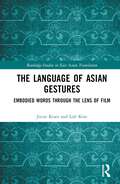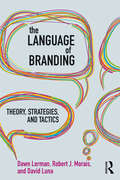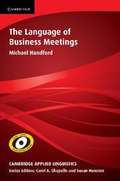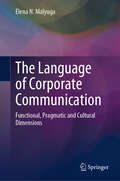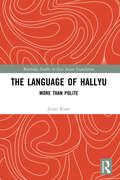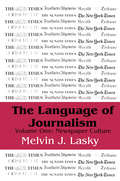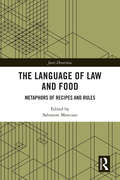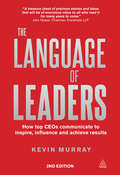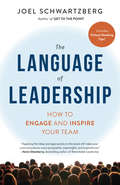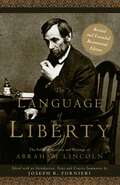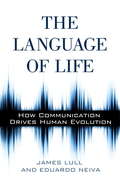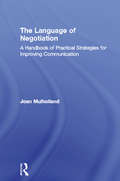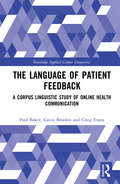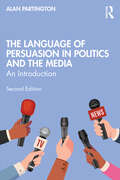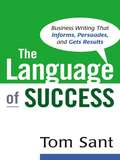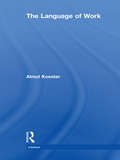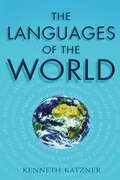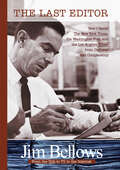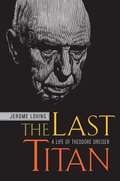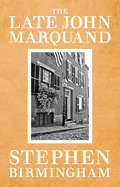- Table View
- List View
The Language of Asian Gestures: Embodied Words Through the Lens of Film (Routledge Studies in East Asian Translation)
by Jieun Kiaer Loli KimThe Language of Asian Gestures explores Asian gestures as a non-verbal language within the context of films and dramas.This book provides a cross-cultural Asian perspective on a range of important common gestures and their meanings, covering a range of Asian regions including Korea, China, Hong Kong, Japan, Taiwan, Vietnam, Singapore, Thailand, Indonesia, the Philippines, India, and Pakistan. While most studies focus on text-based communication, gestures find themselves overshadowed by text and speech. Asian gestures, too, often reside in the shadow of Eurocentric viewpoints. This book will shift this dynamic and amplify the voices that have typically been marginalised within 20th-century Eurocentric discussions.The book will be informative for students and researchers interested in Asian languages, cultures, film studies, and pragmatics. It bridges the gap between words and gestures, unveiling a world of concealed meanings and enriching our understanding of diverse forms of expression.
The Language of Branding: Theory, Strategies, and Tactics
by Dawn Lerman Robert J. Morais David LunaThe Language of Branding: Theory, Strategies and Tactics shows marketers how to use language successfully to improve brand value and influence consumer behavior. Luna and Lerman are among only a few researchers who take a multidisciplinary perspective on the ways language influences how consumers act. Together with Morais, an anthropologist engaged in market research, they show how understanding the power of language can impact the essence – and sales – of a brand. The book covers the fundamentals of brand language and applications for an array of marketing initiatives. Readers will learn why brand language matters, how language is used in marketing, and how to build a brand strategy that capitalizes on the richness and complexity of language. This book includes real-world case histories that demonstrate vividly how brand language is created and exercises that enable both students of marketing and marketing professionals to apply the book’s concepts and stimulate class discussion. The Language of Branding: Theory, Strategies and Tactics can be used in a number of courses, including consumer behavior, branding, advertising, linguistics, and communications.
The Language of Business Meetings
by Michael HandfordThis innovative volume presents an in-depth study of the language used by participants in business meetings. The cutting-edge research draws on the Cambridge and Nottingham Business English Corpus (CANBEC), a unique resource which brings together meetings of different types both within and between companies, involving speakers whose roles and responsibilities vary, and who represent a range of nationalities and first languages. Keywords, concordance lines and discourse analysis provide thorough insights into aspects such as the structural stages of meetings, participants' discursive practices, interpersonal language and creativity, and power and constraint. The author concludes by making practical suggestions for using these findings to inform the teaching of business English.
The Language of Corporate Communication: Functional, Pragmatic and Cultural Dimensions
by Elena N. MalyugaThis book explores diverse cultural and linguistic landscapes, unraveling the fusion of language, culture, and corporatism. It breaks new ground by examining lesser-known linguistic-cultural aspects of corporate communication. It provides deeper insights into conversational practices, cultural variations, and gender-specific speech aggression within the corporate realm. The book delves into functional aspects, such as corporate terminology and stylistic techniques, as well as the pragmatic dimension with humor and emotive language. Offering a unique perspective on corporate language, it deepens understanding of semantic dynamics and emphasizes language's power to meet diverse communication needs. The book is a must-read for corporate professionals, linguists, scholars, business leaders, communication consultants, and educators teaching the language of business and corporate communication. It is also an invaluable asset for anyone seeking to navigate the intricacies of corporate communication in today's globalized business landscape.
The Language of Everyday Life: An Introduction
by Judy DelinThis is a lively, practical guide that provides a fascinating linguistic description of six familiar text and discourse types, showing how language works in everyday life to perform its particular purpose. Through original examples, students are introduced to a wide-ranging repertoire of analytical concepts and techniques, described in basic, clear terms, and drawn from a broad range of areas of linguistics and language study. The aim of the book is to enable students to discover for themselves what is interesting about different language situations, and to begin to interrogate the relationship between language, society, and ideology. The Language of Everyday Life includes: topics for discussion; exercises, and; further readings; extensive glossary of technical terms; a practical guide to project work.
The Language of Hallyu: More than Polite
by Jieun KiaerThe Language of Hallyu will re-examine the language of the Korean Wave by looking at popular K-content. In doing so, it will expose the meanings that get lost in translation, hidden under subtitles. Over the past decade, hallyu (the Korean wave) has exploded in popularity around the globe. K-films, K-drama, and K-pop were once small subcultures, known mostly by Korea’s East and Southeast Asian neighbours and Korean diaspora. Now, K-content has entered the international mainstream. Consequently, interest in Korean language has grown, while interest in language learning in general has decreased. Many textbooks emphasise that Korean is a ‘polite’ language, but this book will highlight that this is not the case. The Language of Hallyu examines popular K-content, including Parasite (2019), Minari (2020), Squid Game (2021), and Pachinko (2022). The author introduces language stylistics to explain how Koreans style their language to suit every occasion. She argues that they do this via a process of visual scanning and social tuning, whereby visual clues are assessed in tangent with an individual’s sociocultural awareness. The author concludes by highlighting the danger of the jondaemal/banmal (polite/casual speech) divide, demonstrating that Korean language is so much more than polite. This book will be of interest to students and researchers in Korean language and culture, particularly those interested in linguistics and pragmatics.
The Language of Journalism: Volume 1, Newspaper Culture (Language Of Journalism Ser.)
by Melvin J. LaskyThe newspaper is to the twentieth century what the novel was for the nineteenth century: the expression of popular sentiment. In the first of a three-volume study of journalism and what it has meant as a source of knowledge and as a mechanism for orchestrating mass ideology, Melvin J. Lasky provides a major overview. His research runs the gamut of material found in newspapers, from the trivial to the profound, from pseudo-science to habits of solid investigation.The volume is divided into four parts. The first attacks deficiencies in grammar and syntax with examples from newspapers and magazines drawn from the German as well as English-language press. The second examines the key issues of journalism: accuracy and authenticity. Lasky provides an especially acute account of differences between active literacy and passive viewing, or the relationship of word and picture in defining authenticity.The third part emphasizes the problem of bias in everything from racial reporting to cultural correctness. This is the first systematic attempt to study racial nomenclature, identity-labeling, and literary discrimination. Lasky follows closely the model set by George Orwell a half century earlier. The final section of the work covers the competition between popular media and the redefinition of pornography and its language. The volume closes with an examination of how the popular culture both influenced and was influential upon literary titans like Hemingway, Lawrence, and Tynan.
The Language of Law and Food: Metaphors of Recipes and Rules (Juris Diversitas)
by Salvatore MancusoThis book reconsiders the use of food metaphors and the relationship between law and food in an interdisciplinary perspective to examine how food related topics can be used to describe or identify rules, norms, or prescriptions of all kinds. The links between law and food are as old as the concept of law. Many authors have been using such links in creative ways to express specific features of law. This is because the language of food and cooking offers legal thinkers and teachers mouth-watering metaphors, comparing rules to recipes, and their combination to culinary processes. This collection focuses on this relationship between law and food and takes us far beyond their mere interaction, to explore different ways of using these two apparently so diverse elements to describe different phenomena of the legal reality. The authors use the link between food and law to describe different aspects of the legal landscape in different areas and jurisdictions. Bringing together metaphors and indirect correlations between law and food, the book explores different models of approaching legal issues and considering different legal challenges from a completely new perspective, in line with the multidisciplinary approach that leads comparative legal studies today and, to a certain extent, revisiting and enriching it. With contributions in English and French, the book will be of interest to academics and researchers working in the areas of law and food, law and language, and comparative legal studies.
The Language of Leaders
by Kevin MurrayThe traditional model for what constitutes a good leader is changing and CEOs and HR professionals now say the ability to understand, motivate and inspire others is the characteristic that is most important when recruiting senior leaders. Based on original interviews with an extraordinary list of 60 top leaders from a wide range business and public sectors, The Language of Leaders, now in paperback, provides a unique insight into how they have responded to the demands of a transparent world, reports on what they have learned, and creates a lexicon for successful communication. Their message is resoundingly clear - communication is a now a crucial top three skill of leadership. Filled with actionable lessons and insights from leading CEOs of high-profile global organisations, The Language of Leaders is a book that anybody in a leadership position, or who aspires to lead, should read and keep on their desks.
The Language of Leadership: How to Engage and Inspire Your Team
by Joel SchwartzbergConvey the essence of leadership with every communication. Everything you communicate has the power to secure or sabotage your impression. But while you may be an empathic, visionary, responsive, inspiring, authentic, supportive, and humble leader, the lasting impact of those qualities hinges on your ability to communicate them effectively in words and expressions. Drawing on his decades of experience as a presentation coach, executive speechwriter, and national champion public speaker, Joel Schwartzberg offers unique mindsets, actionable tactics, and diverse examples to help you leverage the most powerful leadership tool you have: your voice. Whether you're giving speeches, telling stories, sending emails, posting messages, recording videos, or running Zoom meetings, these are essential practices for establishing authority and engaging your audience. The Language of Leadership will show you how to inspire, not merely inform, communicate with purpose and power, and sell—not just share—your most important ideas.
The Language of Liberty: The Political Speeches And Writings Of Abraham Lincoln:bicentennial Edition (Gateway Heritage Series)
by Joseph R. FornieriThe Civil War is a defining event in American history and Abraham Lincoln is the central figure of both the Civil War and American history. In his struggle to preserve the Union and redeem the nation from the original sin of slavery, Abraham Lincoln provided the most compelling expression of the American Dream and the preeminent justification of the American regime. Indeed, at Gettysburg he distilled the very essence of the nation's political creed. His political thought and leadership are of enduring significance to democracy at home and abroad. <P><P>To further appreciate and perpetuate Lincoln's legacy, The Language of Liberty offers the definitive one-volume collection of the Sixteenth President's speeches and writings. Unlike so many other collections, in which Lincoln's speeches and writings have been substantially edited, this volume provides a comprehensive selection of the Sixteenth President's most important speeches and writings in their entirety.The volume is conveniently divided both chronologically and thematically into five periods/chapters from 1832-1865. <P><P>A final chapter offers a compilation of Lincoln's speeches and writings on the theme of religion and politics. Each speech is preceded by an informative head-note, which places Lincoln's words in context for the reader. In addition, each period/chapter includes a concise historical, political, and biographical overview of the major events in Lincoln's life and the life of the nation, thereby providing an even wider context for understanding the Sixteenth President's language of liberty. <P><P>To assist the reader, crucial terms, dates, events and issues of the Civil War have been defined. Also unique to this volume is the final section on Lincoln's Political Faith, which includes an offering of his public and private utterances on religion, and a definition of this political faith based upon the first principles of the Declaration of Independence.A selected bibliography of secondary sources has been included for further reading on various topics related to the Sixteenth President. <P><P>Finally, the volume includes an extensive introduction on Lincoln's Prudent Leadership and his application of the natural law to the circumstances of the Civil War Era. Indeed, this introduction provides a crucial understanding of the relationship between Lincoln's political thought and political action, between the world of theory and practice. <P><P>In sum, The Language of Liberty provides an indispensable guide to the lay reader, the Lincoln aficionado, and the scholar. All now have access to a single volume collection of his great political speeches and writings with unedited versions, concise historical overviews, and scholarly reflections on the enduring significance of Lincoln's political philosophy.
The Language of Life
by James LullCommunication in its most basic form--the sending of signals and exchange of messages within and between organisms--is the heart of evolution. From the earliest life-forms to Homo sapiens, the great chain of communication drives the evolutionary process and is the indispensable component of human culture. That is the central message of this unique perspective on both the biological evolution of life and the human development of culture. The book explores the totality of communication processes that create and sustain biological equilibrium and social stability. The authors argue that this ubiquitous connectivity is the elemental unity of life. Introducing a new subdiscipline--evolutionary communication--the authors analyze the core domains of life--sheer survival, sex, culture, morality, religion, and technological change--as communications phenomena. What emerges from their analysis is a brilliant interpretation of life interconnected through communication from the basic molecular level to the most sophisticated manifestations of culture. Challenging the boundaries of conventional approaches to cultural analysis, this is an original and engaging view of evolution and an encouraging prognosis for our collective future.
The Language of Life and Death
by William LabovWe share the experience of others through the stories they tell of the crucial events in their lives. This book provides a rich range of narratives that grip the reader's attention together with an analysis of how it is done. While remaining true to the facts, narrators use linguistic devices to present themselves in the best possible light and change the listener's perception of who is to blame for what has occurred. William Labov extends his widely used framework for narrative analysis to matters of greatest human concern: the danger of death, violence, premonitions, and large-scale community conflicts. The book also examines traditional epic and historical texts, from Herodotus and the Old Testament to Macaulay, showing how these literary genres draw upon the techniques of personal narratives. Not only relevant to students of narratology, discourse and sociolinguistics, this book will be rewarding reading for anyone interested in the human condition.
The Language of Negotiation: A Handbook of Practical Strategies for Improving Communication
by Joan MulhollandThe Language of Negotiation aims to heighten awareness of language and to suggest practical ways to use language-related tactics to get results. It encourages the reader to recognise negotiation as a specifically language-centred activity and demonstrates how learning to use language effectively can radically improve negotiation skills. The book features: A step-by-step guide on the practice of negotiation, from preparation to follow-up after the event Chapters on various aspects of negotiation, such as the spoken, written and interpersonal sides, as well as media interviewing and using the phone. Specific and useful strategies for actions like advising, complaining, confirming and dismissing. A range of effective and informative examples throughout, designed to show the value of enhanced language use and practical exercises to encourage the reader to apply the ideas to their own practice. The Language of Negotiation will be of value to all those in business and professional life whose work involves negotiation. It will also be of particular interest to students in graduate schools of business or management and to anyone who has an interest in improving their negotiation skills. No prior knowledge of language theory is assumed on the part of the reader.
The Language of Organizational Styling
by Lionel WeeThe ways in which commercial organizations and service providers 'style' themselves - creating the image they wish to portray to their potential consumers - is a long-established area of research in the fields of sociology and business studies. However language also plays an important role in organizational styling, something which until now has been largely overlooked in the literature. This is the first book-length study of the linguistics of organizational styling, looking at the language and semiotic resources used by holiday resorts, pharmaceutical companies, restaurants and insurance companies in order to project their identities, and style themselves. It discusses in detail a number of case studies and presents an innovative take on the notion of style, as well as bringing together work from linguistics, business studies and sociology. This interdisciplinary book will be of interest to scholars and advanced students in sociolinguistics, and scholars of sociology and business studies.
The Language of Patient Feedback: A Corpus Linguistic Study of Online Health Communication (Routledge Applied Corpus Linguistics)
by Paul Baker Craig Evans Gavin BrookesThe Language of Patient Feedback provides a unique insight into a diverse range of issues related to healthcare. Through the comprehensive and detailed interrogation of 29 million words of online patient feedback on the NHS in England, as well as 11 million words of responses to the feedback from NHS providers, this book: Uses a combination of computer-assisted and human analysis (Corpus-Assisted Discourse Analysis) to examine the extent to which characteristics like age and gender result in different types of evaluation. Investigates why nurses, doctors, dentists and receptionists are associated with very distinct types of feedback. Demonstrates the ways that NHS staff respond to comments and what this reveals about underlying institutional ideologies and practices. Concludes with suggestions for key recommendations that the NHS could act upon to improve the overall level of care it provides, as well as reflecting on what patient evaluation can actually tell us. The Language of Patient Feedback is key reading for anyone undertaking research within corpus linguistics, discourse analysis and health communication.
The Language of Persuasion in Politics and the Media: An Introduction
by Alan PartingtonThis bestselling introductory textbook examines the relationship between politicians, the press and the public through the language they employ. Now fully revised with new material on delegitimisation, ‘fake news’, disinformation, (self-)censorship, ‘conspiracy theories’ and ‘Zombie’ narratives, key topics include:• Evaluation, the ‘engine’ of persuasion.• ‘Spin’, ‘spin control’ and ‘image’ politics.• Models of persuasion, including authority, contrast, problem-solution, association, ‘garden path.’• Pseudo-logical and ‘post-truth’ arguments.• Humour, irony and satire.• Metaphors: use, misuse and dangers.• Election rhetoric.Extracts from speeches, soundbites, newspapers and blogs, social media, interviews, press conferences, election slogans and satires are used to provide the reader with the tools to discover the beliefs, character and hidden strategies of the would-be persuader, as well as the counter-strategies of their targets. This book demonstrates how the study of language use can help us appreciate, exploit and protect ourselves from the art of persuasion.With a wide variety of practical examples, on both recent issues and historically significant ones, every topic is complemented with guiding tasks, queries and exercises, with keys and commentaries at the end of each unit. This highly original textbook is ideal for all introductory courses on language and politics, media language, rhetoric and persuasion, discourse studies and related areas.
The Language of Service Encounters: A Pragmatic-Discursive Approach
by J. César Félix-BrasdeferService encounters are ubiquitous in social interaction. We buy food and everyday items in supermarkets, convenience stores, or markets; we purchase merchandise in department stores; or we request information at a visitor information center. This book offers a comprehensive account of service encounters in commercial and non-commercial settings. Grounded in naturally occurring face-to-face interactions and drawing on a pragmatic-discursive approach, J. César Félix-Brasdefer sets out a framework for the analysis of transactional and relational talk in various contexts in the United States and Mexico. This book investigates cross-cultural and intra-lingual pragmatic variation during the negotiation of service. The author provides a broad review of research on service encounters to date, and analyzes characteristics of sales transactions, such as participants' roles, pragmatic and discourse functions of relational talk and address forms, the realization of politeness, and changes in alignment from transactional to relational talk. Examines face-to-face interactions in commercial and non-commercial service encounter settings, including the analysis of transactional and non-transactional talk. Analyzes pragmatic and sociolinguistic variation, including linguistic, regional, intra-lingual, and gender variation. Reviews and evaluates methods and techniques for the collection and analysis of corpus data in service encounters in naturalistic settings.
The Language of Success: Business Writing That Informs, Persuades, And Gets Results
by Tom SantLanguage is the medium of business. To be successful, we need to communicate effectively in writing. That’s true whether we are providing instructions to our colleagues, communicating with our customers, or advising our direct reports. We must be able to deliver clear, accurate messages that inform, persuade and motivate. Unfortunately, people lapse into habits that interfere with their ability to communicate. The Language of Success shows readers ho to avoid these mistakes, and to write lucid, concise, and accurate e-mails, letters, performance appraisals, and presentations. Now anyone can master the lost art of clear writing and: * eliminate ambiguities, jargon and grandiose claims * master proper paragraph structure so the message doesn’t get muddled * avoid wishy-washy or misleading terms like "world class" or "state of the art" * write clear concise sentences that follow the "first time right rule" * use e-mail professionally and efficiently * create career-enhancing reports Honest and authoritative, The Language of Success will gives readers practical techniques to help readers cut through the fluff, guff, geek, and hyperbole, write exceptional business documents, and get their message heard.
The Language of Trust
by Michael MaslanskyWhat to say, how to say it, and why it matters: communicating with authority and honesty in an age of mistrust. Still struggling through the financial crisis that began in 2008, consumers aren't buying traditional sales approaches anymore. So how do salespeople, corporate communicators, managers, and marketers sell their ideas, products, and services to a generation of customers who are more skeptical and less influenced by conventional marketing than ever before? Based on groundbreaking consumer research conducted with thousands of individuals, this step-by-step guide will help readers understand their audience and how to communicate effectively with them. Topics include: The mechanics and mindset of communicating with trust and credibility Choosing the right words: being positive, using plain English, being plausible, and personalizing a message Structuring a message: putting benefits before features, context before specifics, engagement before discussion, and customers' interests before the company's Case studies from personal finance, consumer products, public utilities, and other areas
The Language of Work (Intertext)
by Almut KoesterThe Intertext series has been specifically designed to meet the needs of contemporary English Language Studies. Working with Texts: A Core Introduction to Language Analysis (second edition 2001) is the foundation text, which is complemented by a range of 'satellite' titles. These provide students with hands-on practical experience of textual analysis through special topics, and can be used individually or in conjunction with Working with Texts. The Language of Work: examines how language is used in business and the workplace, looking at a range of situations and data: from meetings to informal negotiations, promotional letters to emails explores representations of work in advertising, career magazines and workplace talk looks at the way people in business interact through small talk, politeness, customer care and management-employee relationships is illustrated with lively examples taken from the real world and includes a full index of terms features a useful section on entering the world of work, exploring job adverts and texts that give advice on CV writing and developing 'transferable skills'.
The Languages of the World
by Kenneth Katzner Kirk MillerThis third edition of Kenneth Katzner's best-selling guide to languages is essential reading for language enthusiasts everywhere. Written with the non-specialist in mind, its user-friendly style and layout, delightful original passages, and exotic scripts, will continue to fascinate the reader. This new edition has been thoroughly revised to include more languages, more countries, and up-to-date data on populations.Features include:*information on nearly 600 languages*individual descriptions of 200 languages, with sample passages and English translations*concise notes on where each language is spoken, its history, alphabet and pronunciation*coverage of every country in the world, its main language and speaker numbers*an introduction to language families
The Last Editor: How I Saved the New York Times, the Washington Post, and the Los Angeles Times from Dullness and Complacency
by Jim BellowsThe innovative newspaper editor chronicles his storied career in this memoir, featuring sidebars from the like of Tom Wolfe, Katherine Graham, and more.The Last Editor is the memoir of Jim Bellows, the editor whose David-and-Goliath battles changed the face of the newspaper business. Bellows struggled to save major competitors of America’s three most powerful newspapers: the New York Times, the Washington Post, and the Los Angeles Times. In doing so, he developed major talent from rough cuts and brought a new generation of writers to the mainstream press.The Last Editor is a unique memoir of a man who loved a fight—highlighted with commentary from his colleagues in letters and sidebars from the biggest names in media. Sidebars from Tom Wolfe, Ben Bradlee, Art Buchwald, Katherine Graham, Mary McGrory, William Safire, just to name a few, and 16 pages of black-and-white photos, provide behind-the-scenes insights to the triumphs and controversies of the man who shaped the industry.“This is a lively, engaging recollection of the glory days of newspapers with amusing stories of the fabled men and women of journalism at a time when many American cities supported at least two newspapers.” —Booklist
The Last Titan: A Life of Theodore Dreiser
by Jerome LovingA standard biography of one of America's best novelists, Theodore Dreiser, this book paints a full portrait of a writer who boldly swept away Victorian timidity to open the twentieth century in American literature.
The Late John Marquand
by Stephen BirminghamThe acclaimed social historian and author of Our Crowd presents a colorful portrait of the Pulitzer Prize–winning writer. John Marquand, the great literary satirist and chronicler of New England elites, could have been a character in one of his own beloved novels. Here, Stephen Birmingham presents a lively narrative of Marquand&’s life, drawing on personal interviews with friends and family. Raised in Newburyport, Massachusetts, Marquand was both an insider and outcast of the old money set. After attending Harvard and serving overseas in World War I, he began writing stories that captured the lives, manners, and morals of wealthy families confined by their own privilege. Marquand himself joined the ranks of these exclusive families by marrying into them—twice. In The Late John Marquand, Birmingham provides an intimate portrait of the man behind such works as H. M. Pulham, Esquire, and The Late George Apley, which won the Pulitzer Prize in 1938.
